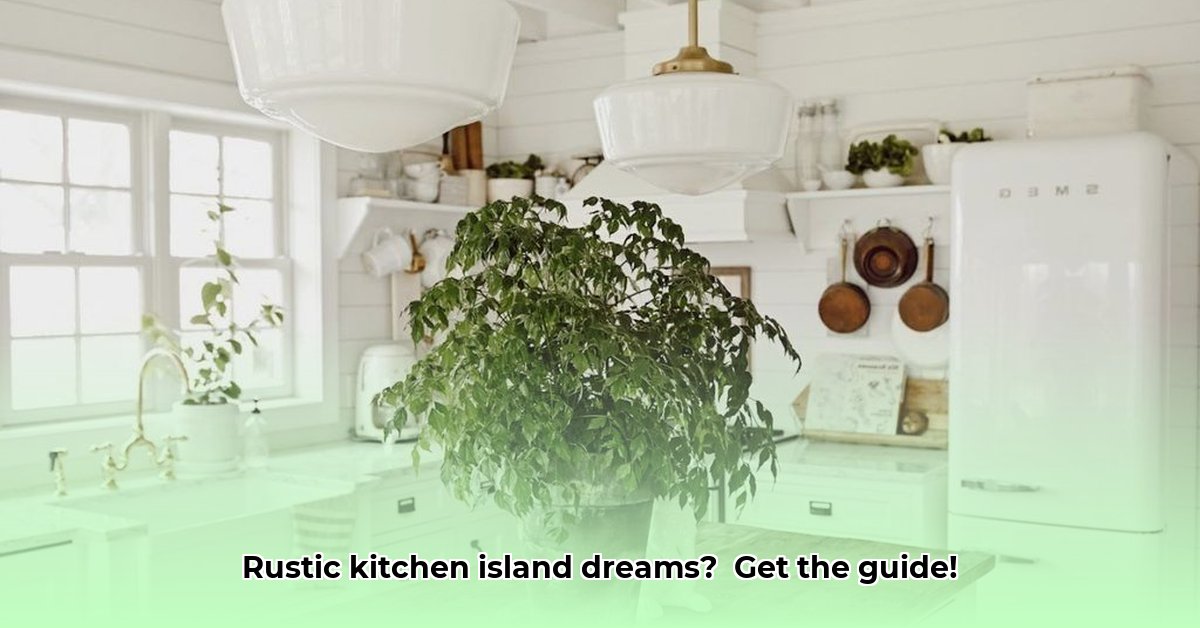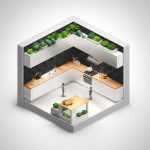Want a kitchen that’s both gorgeous and super practical? This guide is your secret weapon for creating the perfect rustic kitchen island. We’ll walk you through everything from choosing the best materials (reclaimed wood, metal, and more) to DIY build steps, design tips, and maintenance. For added comfort underfoot, consider a kitchen rug. Let’s build the rustic kitchen of your dreams!
Rustic Kitchen Island Styles and Dream Designs
Ready to give your kitchen a major upgrade? Let’s build the rustic kitchen island of your dreams! This isn’t just about adding a countertop; it’s about adding heart and functionality to the place where you cook, eat, and gather. Multifunctional islands with reclaimed wood and those incorporating smart technology integration are especially popular.
Choosing the Perfect Materials: Rustic Kitchen Island Foundation
The materials you select will set the tone for your entire island. Let’s explore popular options and determine the best foundation material for your island build or remodel:
-
Reclaimed Wood: This is a classic choice for rustic kitchens, offering beautiful grain and character. It’s environmentally friendly, too! Reclaimed wood can be more susceptible to damage from moisture, but regular sealing with products like polyurethane or varnish is essential. Sourcing from reputable suppliers ensures the wood is properly treated and free of pests.
-
Metal Accents: Metal adds a cool, industrial edge to any rustic design, complementing wood beautifully. Stainless steel and wrought iron are durable and relatively easy to clean. Some metals can be prone to rust if not properly maintained, so protective coatings or finishes are recommended.
-
Butcher Block Countertops: Offer a warm, natural look and are ideal for food preparation. Regular oiling with food-safe mineral oil is crucial to prevent drying and cracking. Butcher block is also susceptible to staining, so prompt cleanup is important.
-
Marble Countertops: Marble exudes luxury and sophistication. While stunning and sturdy, it’s also more delicate than some other choices, being prone to staining and chipping, so it requires extra TLC like regular sealing with a quality stone sealant and gentle cleaning with pH-neutral cleaners.
-
Porcelain Sinks: These are a fantastic choice for durability and ease of cleaning. Porcelain is resistant to stains and scratches but can be slightly more pricey than other sink materials. Fireclay sinks offer similar benefits with a slightly different aesthetic.
Here’s a quick comparison table illustrating the pros and cons of these materials for your rustic kitchen:
| Material | Pros | Cons |
|---|---|---|
| Reclaimed Wood | Unique character, eco-friendly, warm aesthetic, tells a story of time, adds texture and visual interest | Needs regular sealing, vulnerable to moisture damage, may require sourcing from reputable suppliers, can contain imperfections or inconsistencies |
| Metal Accents | Durable, industrial style, easy to clean, adds a sleek and modern contrast | Potential for rust (depending on type of metal), can be pricey, may require specialized cleaning products |
| Butcher Block | Warm, natural look, ideal for food prep, durable and long-lasting with proper care | Requires regular oiling, susceptible to staining and scratching, can be damaged by excessive moisture |
| Marble Countertops | Elegant, sophisticated, durable (with care), timeless elegance, adds a luxurious feel | Prone to stains and chipping, requires regular maintenance and proper sealing, can be expensive, porous and susceptible to damage from acidic substances |
| Porcelain/Fireclay Sinks | Easy to clean, durable, resistant to stains and scratches, classic and timeless look, available in a variety of styles | Can be expensive, heavy and require sturdy support, susceptible to chipping if subjected to heavy impact |
Designing for Functionality: How to Build an Island
Your rustic kitchen island shouldn’t just look amazing; it should work amazing. Before you even think about aesthetics, consider how you want to use your island. Will it be a main prep zone, a casual dining spot, or a combination of both? Multifunctional islands are in high demand, serving as prep zones, dining spaces, and storage hubs. Consider incorporating features like a prep sink with a garbage disposal, a built-in cutting board, or even a warming drawer.
Here are some ideas to spark your imagination and increase functionality. Consider each element when designing the layout of your island:
-
The Classic Rectangular Island: Offering plenty of counter space for food preparation and extra storage underneath, it’s versatile and fits into most kitchen layouts.
-
The Multifunctional Marvel: Incorporating seating, this larger island transforms into a casual dining area, perfect for family meals or entertaining friends. Consider adding a beverage fridge or a small dishwasher for added convenience.
-
The Space-Saving Compact Island: Ideal for smaller kitchens, a compact island provides extra workspace and storage without overwhelming the room, making the most of your space. Consider a rolling island for even greater flexibility.
-
The L-Shaped Solution: This design takes advantage of corner space, creating a unique and efficient workspace, providing distinct zones for prepping, cooking, and serving.
Consider Built-In Storage: Don’t underestimate the value of built-in storage. Drawers are perfect for utensils and cookware, while open shelving lets you showcase beautiful dishes and cookbooks. A dedicated wine rack adds a touch of rustic charm, and a butcher block countertop extension dramatically increases your prep space. Consider pull-out shelves for easy access to stored items, or a spice rack for convenient organization.
DIY vs Professional Installation: Rustic Kitchen Island Guide
Are you handy? A simpler rustic kitchen island constructed from reclaimed wood might be a DIY project, especially if you enjoy woodworking and have experience with power tools. However, intricate joinery, plumbing for a sink, electrical work for outlets, or complex designs typically require a professional. Consider your skill level, available time, and the complexity of your design. If in doubt, hiring a professional ensures a quality outcome, adherence to building codes, and avoids potential headaches down the line. The added cost of professional installation often brings peace of mind and a guaranteed, high-quality result. Strong joints like mortise and tenon, or carefully-applied dowels, prevent shifting and cracking over time, with weak joints leading to instability. Obtain multiple quotes and check references before hiring a contractor.
Style and Design: Vintage vs Modern Rustic
Your kitchen island should reflect your personal style and blend seamlessly with your existing kitchen décor. Do you envision a vintage-inspired space with warm, reclaimed wood and distressed finishes, or a more modern, industrial-rustic vibe with sleek metal accents and clean lines? Remember to consider the overall style of your kitchen – the island should complement, not clash, with the existing design. Pay attention to details like hardware (knobs, pulls, hinges) and finishes to create a cohesive look. Don’t forget lighting! Pendant lights above the island add a warm glow and enhance the overall ambiance. Consider the size, style, and finish of your pendant lights to complement your island’s design.
Budgeting for Your Dream Island: Practical Tips
Before you start shopping, set a realistic budget and stick to it. The cost of materials varies greatly. Reclaimed wood, for example, can range in price depending on the type of wood, its condition, and its source, while metal finishes and marble countertops generally sit at the higher end of the pricing scale. DIY projects can often save money on labor, but factor in the time involved, the cost of materials, and the potential for mistakes. Remember, budgeting isn’t about restricting your dreams; it’s about making informed decisions to achieve them. Consider prioritizing essential features and making compromises on less important elements to stay within your budget. Shop around for the best prices on materials and consider purchasing reclaimed or salvaged items to save money.
How to Maintain a Rustic Kitchen Island with Reclaimed Wood
Consistent care is key to preserving its beauty and functionality. Key takeaway: proper sealing protects against moisture and stains for your reclaimed wood island. Cleaning spills promptly prevents stains and damage.
Choosing Your Reclaimed Wood: Durability Aspects
Before you even think about building or buying your rustic island, the type of reclaimed wood you choose significantly impacts its longevity and how much maintenance it needs. Some woods are naturally more durable than others such as hardwoods like oak, maple, and walnut. Softwoods like pine require more frequent care and are more susceptible to damage.
Consider these factors:
-
Wood Type: Hardwoods like oak, maple, or walnut are more resistant to wear and tear. Softer woods might require more frequent attention.
-
Condition: Inspect the wood carefully for any existing damage, cracks, or insect infestations. Addressing these beforehand prevents future problems. Look for signs of rot or decay.
-
Source: Reputable suppliers ensure properly treated and seasoned wood, minimizing issues later on. Ask about the wood’s history and previous use.
How to Maintain a Reclaimed Wood Rustic Kitchen Island: Maintenance Steps
This section is dedicated to the heart of the matter: how to maintain a reclaimed wood rustic kitchen island.
- Regular Cleaning: Wipe up spills immediately with a clean, dry cloth, and use a slightly damp (not soaking wet!) cloth and a mild cleaner (such as dish soap diluted in water) for routine cleaning, avoiding harsh chemicals or abrasive cleaners that can damage
- Black Backsplash Ideas: Stylish Kitchen Transformations to Inspire You - November 8, 2025
- Dark Backsplash Ideas: Drama and Depth for Your Kitchen - November 7, 2025
- Black Backsplash Tile: Find The Perfect Style For Your Kitchen - November 6, 2025










